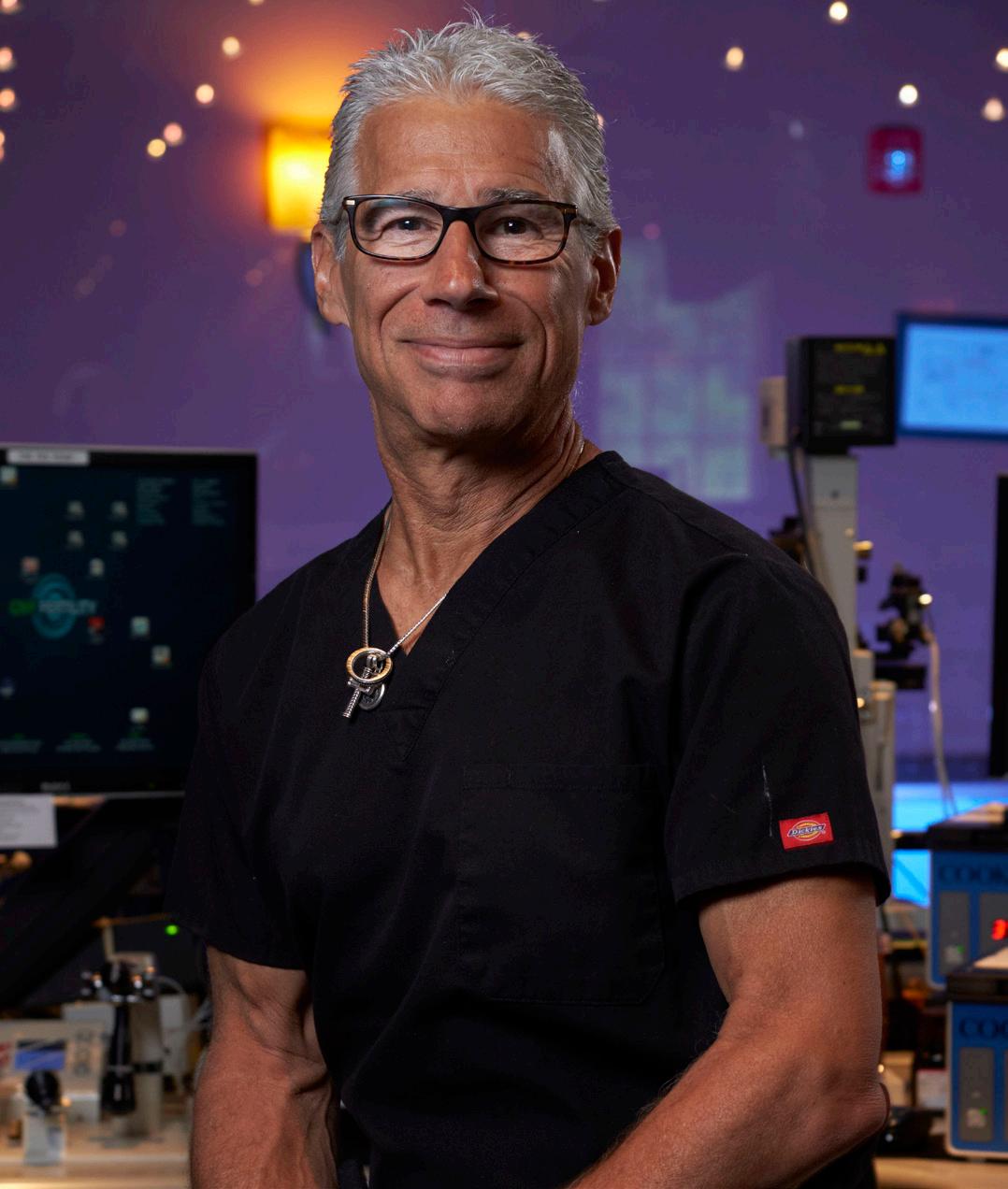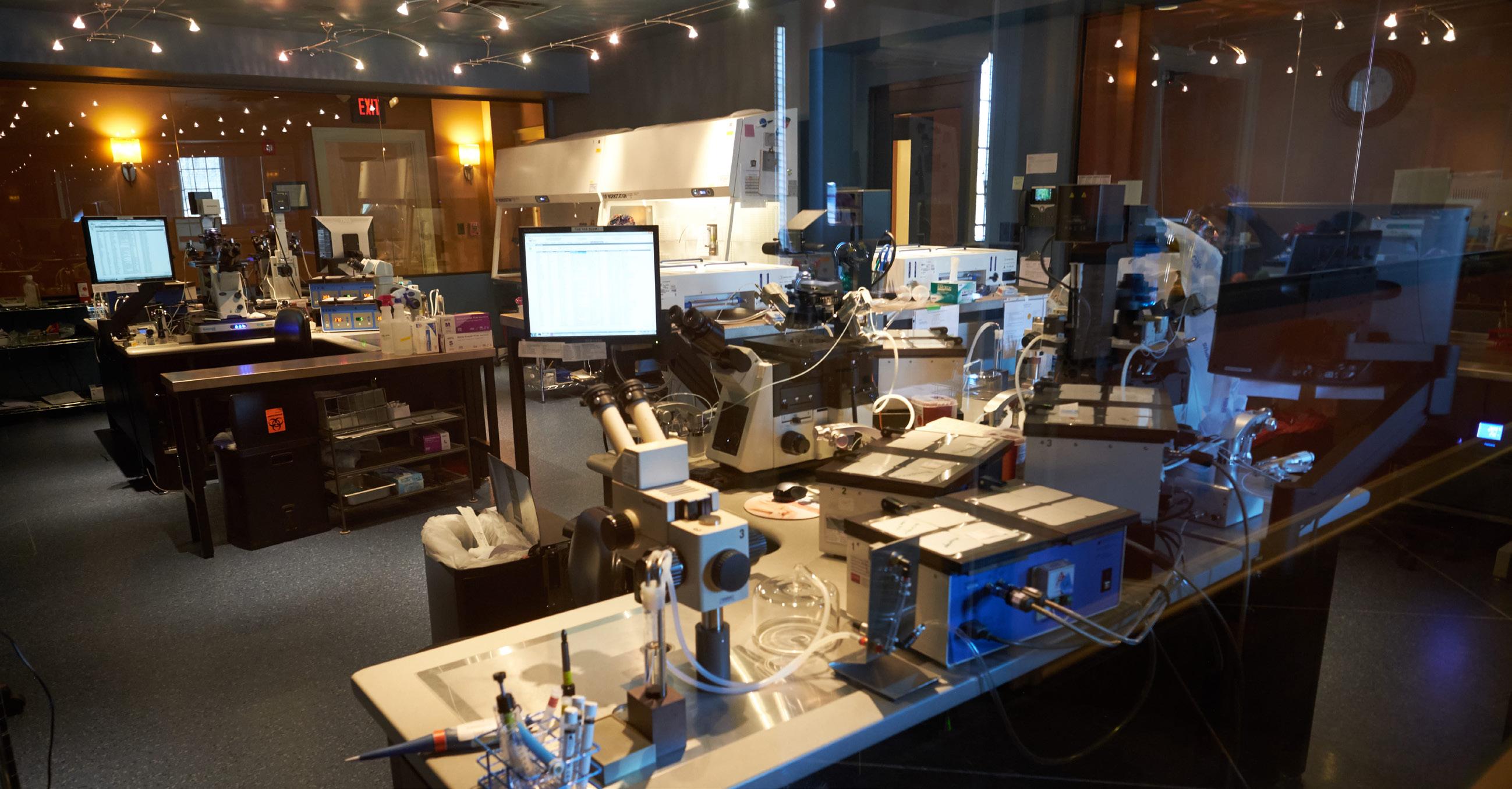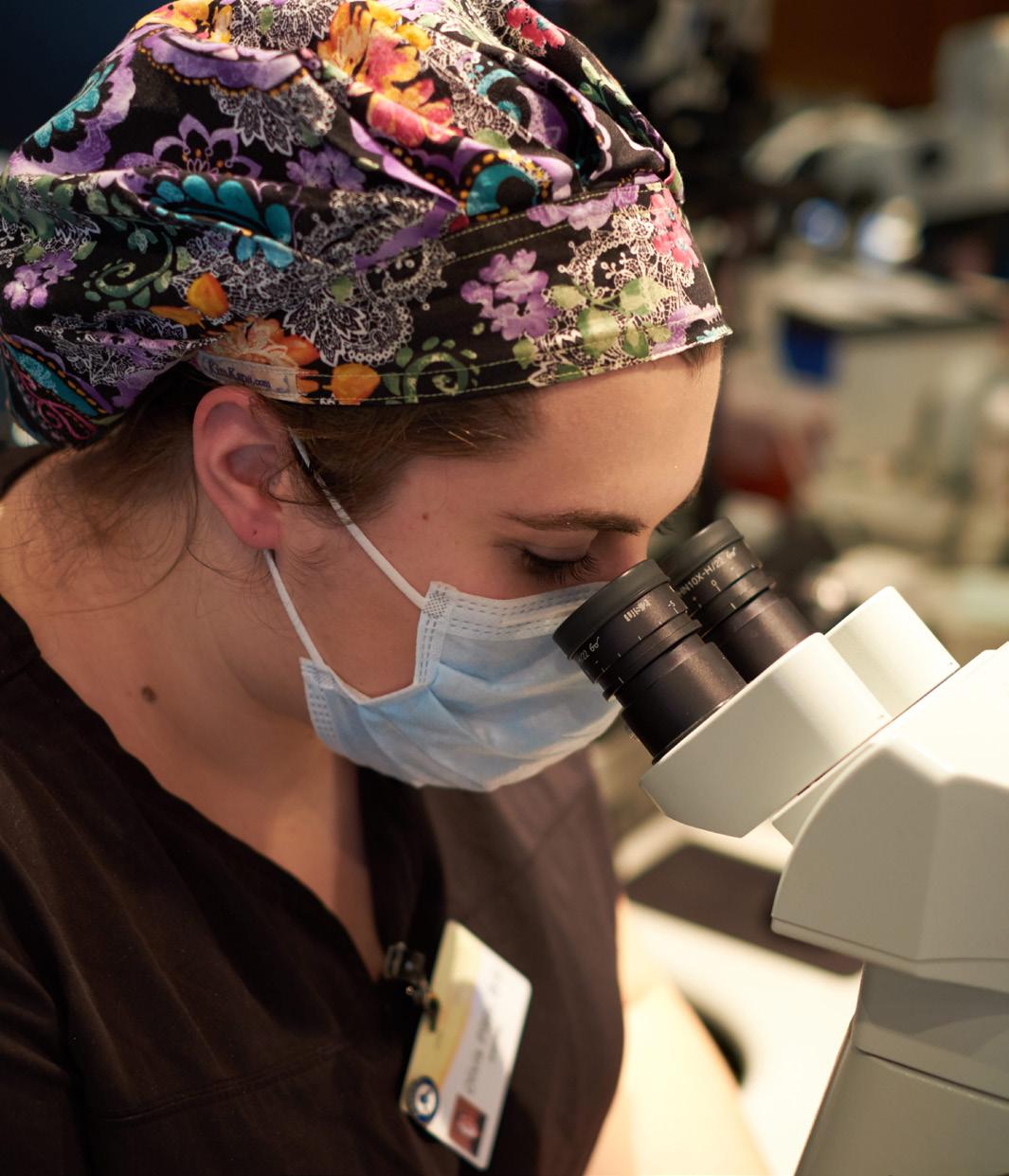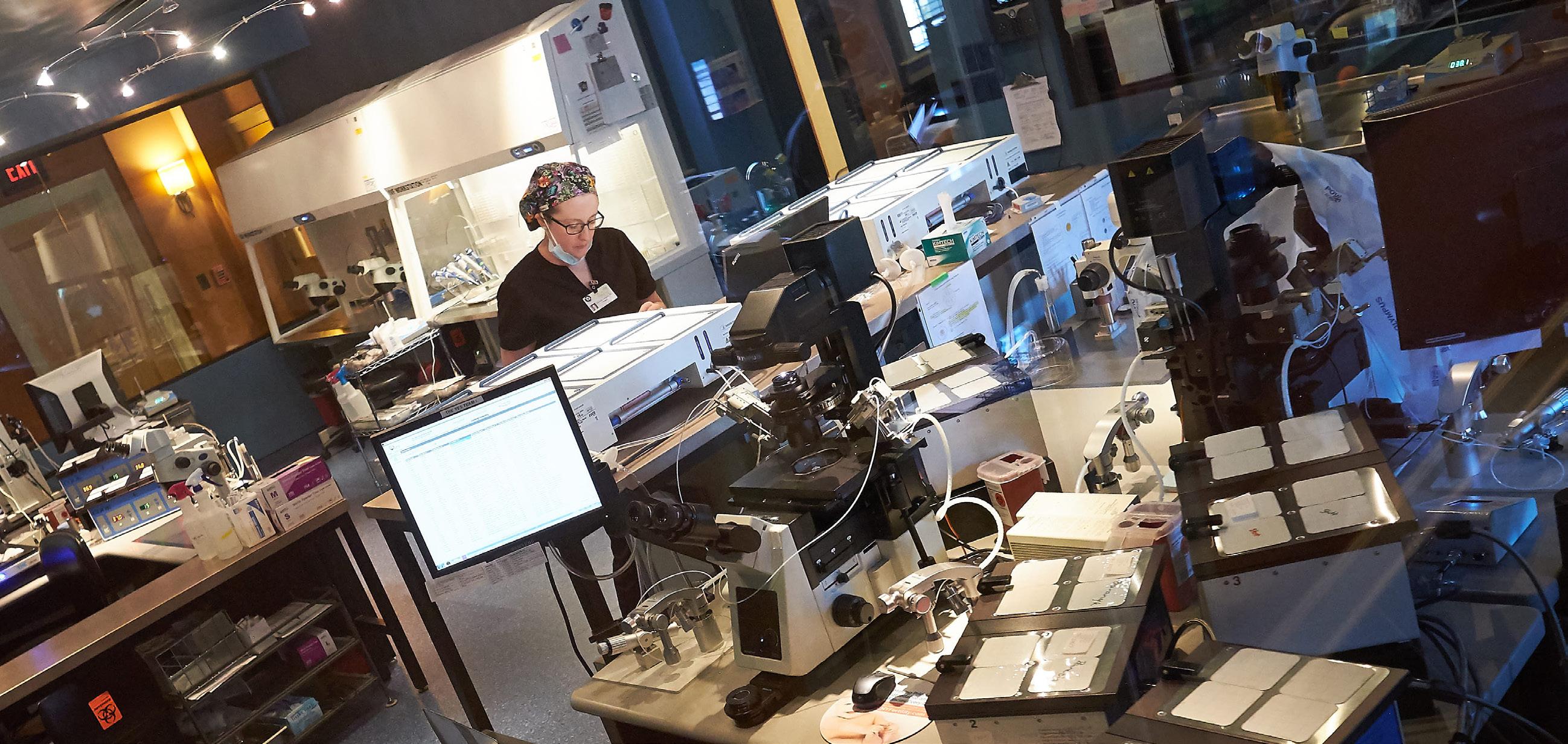
45 minute read
Meet Our Team
Polycystic Ovarian Syndrome (PCOS)
Polycystic Ovarian Syndrome or PCOS is one of the mostcommon hormonal endocrine disorders in women. Many women have it, and yet we don’t know why, nor do we know the cause. In general, PCOS is really just that –polycystic ovaries. The basic difference between polycystic and normal ovaries is that although the polycystic ovaries contain many small follicles with eggs in them, the follicles do not develop and mature properly, so there is no ovulation.
Women suffering from PCOS may experience high testosterone levels, which cause other signs and symptoms such as Hirsutism (excessive hair growth), male pattern baldness and acne. This high level of testosterone can prevent the ovaries from releasing an egg each month causing irregular menstrual cycles and, ultimately, infertility.
Many women struggle with PCOS for years, and it’s only when they have difficulty conceiving and seek fertility assistance that they learn the reason for so many of their symptoms. In fact, it is estimated that more than 50 percent of PCOS cases remain undiagnosed.
PCOS is one of the leading causes of infertility among women and is responsible for 70% of infertility issues in women who have difficulty ovulating. It affects nearly 10 percent of women before they hit menopause. Postmenopausal women can also suffer from PCOS. There is some degree of heredity with PCOS. Some studies have found that if a mother has PCOS, there is a 50% chance that her daughter will have PCOS.
SYMPTOMS OF PCOS
Although many of its symptoms are unnoticeable, PCOS can affect a woman’s fertility, menstruation, hormone levels, and physical appearance. Infertility can result from low levels of the hormones necessary to create an egg. If ovulation doesn’t occur, progesterone, a hormone that thickens the lining of the uterus, is not produced. A woman’s cycle will be irregular or absent without progesterone.
Women with PCOS are at additional risk for insulin resistance, type 2 diabetes, high cholesterol, high blood pressure, and heart disease.
Metformin Alone
Clomid
Femara
Injectable gonadotropins
IVF, In vitro fertilization
Many may be overweight and have difficulty with weight control, although you can be lean and still have PCOS.
PCOS cannot be diagnosed with one test alone, and symptoms vary from woman to woman. Additional warning signs include:
• PMS or pelvic pain • Weight gain • Acne • Increased hair growth on face, back or chest • Sleep apnea • Thinning hair/baldness • Dandruff • Elevated cholesterol • High blood pressure • Type II Diabetes
Women with PCOS often have higher levels of insulin in their blood than normal. Insulin regulates the amount of sugar in the bloodstream. Researchers believe that the overproduction of this hormone causes women’s bodies to respond by producing excessive amounts of the male hormone androgen. In a healthy body, the ovaries make a tiny amount of androgen. But with PCOS, they start producing too much. This often causes you to stop ovulating, grow excessive facial and body hair, acne, and makes it difficult to sustain a healthy body weight. That is why proper diet is critical to those who suffer from PCOS.
TREATMENT There is no known cure for PCOS, although it is possible to manage its symptoms medically and through lifestyle modifications.
The Ketogenic diet has produced very good results in managing the symptoms of PCOS. By reducing or eliminating carbohydrates altogether and increasing consumption of saturated fats, a ketogenic diet can lead to significant reductions in About 1-2%
15% - if ovulating
15% - if ovulating
20%
50%
body weight, and lower percent free testosterone, LH/FSH ratio, and fasting serum insulin in as little as six months.
CONCEIVING WITH PCOS The good news is that your chances of getting pregnant with PCOS using fertility treatments are very good. The great majority of women with PCOS will be able to have a baby. Women with PCOS generally need ovulation induction in order to get pregnant. This can be accomplished through the use of oral medications such as metformin, Clomid or Letrozole (Femara). These medications can be effective in stimulating ovulation in some women with polycystic ovaries and anovulation. Metformin is used to reduce high insulin levels and stabilize your hormones. It can be used alone or in combination with Clomid or Femara.
Some women do not respond and ovulate with Clomid, but will respond well to letrozole. Injectables can also be used. For women who do not ovulate with Clomid or Femara, the traditional next step is to use injectable gonadotropins. The woman takes daily shots of FSH hormone for about 10 to 12 days in order to stimulate mature follicle development.
Progressing to IVF is usually recommended after ovulation induction with intercourse and induction with IUI have not resulted in pregnancy.
There are also some surgical interventions, including ovarian drilling. This is when a doctor punctures the ovary with a small needle carrying an electric current to destroy a small portion of the ovary. This surgical procedure may lower male hormone levels and help with ovulation, but it also carries a risk of developing scar tissue on the ovary and the benefits may only last a few months. Both the risks and the benefits of ovarian drilling should be discussed with your doctor to determine if it is the right treatment for you.
Unexplained Infertility= Inflammation

A diagnosis of unexplained infertility or idiopathic infertility is usually made when all of our testing is complete and there is not an obvious source of the problem. The man’s sperm count looks reasonably normal in volume, motility, concentration and morphology. The woman has regular menstrual cycles which indicate she is likely ovulating. The hysterosalpingogram shows that the fallopian tubes and uterus are in normal condition. And, there are no obvious, systemic diseases (such as autoimmune diseases, diabetes, or previous history of cancer, radiation or chemotherapy) that may explain a history of infertility. Ovarian reserve is good and the woman has an AMH (Anti-Müllerian Hormone) level of greater than 1. It is important to understand what unexplained infertility really means:
The diagnostic testing we have available will only identify the major reasons why a couple may have a difficult time getting pregnant and staying pregnant, but it certainly cannot identify all of the reasons.
About 20-30% of couples will have no definitive diagnosis after completing a standard infertility evaluation. True unexplained infertility may be related to egg and sperm dysfunction, among other causes. These conditions are difficult to establish through conventional testing. If the fallopian tubes are blocked or there is no sperm, these are obvious major obstacles to becoming pregnant.
Unfortunately, there are no tests available for more subtle infertility factors such as inadequate egg quality which could result in fertilization failure. In today’s fast-paced treatment paradigm, some patients prefer to move forward with treatment without further clarification. Although oftentimes appropriate, this strategy should not be applied to every patient/couple. Laparoscopy and hysteroscopy are minimally invasive, out-patient surgeries that can provide a diagnosis and sometimes even offer improved pregnancy rates if scar tissue or endometriosis is found and treated at the time of surgery.
It is humbling to put into perspective that even among fertile couples who have no issues getting pregnant, they only have a 20% chance of achieving pregnancy any given month they try. In otherwords, they are unsuccessful 80% of the time!
Dr. Kiltz believes that unexplained infertility is likely related to our daily environment, major and minor stress factors, and diet. Stress and our environment are known to affect cortisol and epinephrine levels, and have a significant effect on the immune system.

TO OUR DAILY ENVIRONMENT,
MAJOR AND MINOR STRESS FACTORS, AND DIET.
There is considerable evidence that diets high in carbohydrates have not only created the significant obesity problem in our modern world, but also an explosive number of autoimmune issues that affect every organ system, including both the female and male reproductive systems.
It is our belief that inflammation is probably the number one source of fertility dysfunction. This means reduced chances of conceiving and implanting, and a significant increase in miscarriages. It may even be related to spontaneous chromosomal abnormalities with DNA damage due to chronic or acute inflammation.
Treatment Options
After thorough testing of both partners and identifying potential factors contributing to a couple’s infertility, treatment options will be recommended based on their individual needs.
If my uterus/fallopian tubes/ovaries are normal, with normal sperm and I appear to be ovulating, my per cycle success is:
Continued trying on own/month Intercourse Cycles with Fertility Medications Intrauterine Insemination (IUI) with Fertility Medications In Vitro Fertilization (IVF) with Fertility Medications Donor Eggs 1-5% per cycle 1-5% per cycle 10-20% per cycle 20-50% per cycle 40-60% per cycle
OVULATION INDUCTION
For those women with ovulation disorders, Polycystic Ovarian Syndrome, or irregular menstrual cycles, an oral hormone medication such as Letrozole (Femara) may be prescribed. These medications are designed to stimulate ovulation. Letrozole is often combined with ultrasound to monitor the ovaries and blood tests to monitor hormone levels. Letrozole can be used in conjunction with both timed intercourse or intrauterine insemination. Gonadotropins are injectable fertility medications that work directly on the ovaries to produce follicles/eggs. The injections are given daily for approximately 10-12 days. During gonadotropin treatment, frequent monitoring with ultrasounds and blood hormone levels is necessary to closely monitor egg/follicle development. If a couple does not conceive after 3-6 cycles of gonadotropins, it is time to reevaluate and move on to alternative treatments.
INTRAUTERINE INSEMINATION (IUI)
For those women whose tubes are not severely damaged and have a normal HSG, intrauterine insemination (IUI) may be an option. In this fairly simple procedure, sperm is placed within the uterus around the time of ovulation. The woman’s eggs are allowed to travel down her tubes on their own. Ovulation induction combined with IUI is often the first course of treatment. IUI alone offers a 3-6%* conception rate per cycle while combining Letrozole with IUI may boost this up to 9%*. Gonadotropins combined with IUI offers a 15-20%* per cycle conception rate (*minimal to mild tubal damage, normal to mild sperm abnormalities and women less than 40 years old.)
In Vitro Fertilization (IVF) offers a much higher chance of success per cycle for tubal damage than surgery. Tubal scar tissue is often inside the fallopian tube, but laparoscopic surgery can only repair the outside of the tube. During IVF, ovaries are stimulated to develop eggs and then the eggs are collected. The eggs are injected with sperm and incubated overnight to fertilize. The resulting embryos are incubated for up to 5 days and are placed in the woman’s uterus.
DONOR EGGS / SPERM
For couples and individuals who experience a lack of eggs or sperm, or whose eggs or sperm will not allow development into viable embryos, using donated eggs or sperm (or both in some cases) is a course of treatment worth consideration. Donors are usually anonymous, though not necessarily so– as in cases using family members or significant others. Egg donation is a viable option for women whose ovaries no longer produce eggs or whose eggs cannot develop into viable embryos. It is also an
Female Fertility Workup
option for those couples who wish to maintain a biological link by using the partner’s sperm. Sperm donation has been around for many years and has been socially acceptable for some time. Not only can a single woman, or women who do not have male partners, become pregnant using donated sperm, but males who have severe sperm abnormalities or no sperm at all, or even potentially serious genetic traits they do not wish to pass on, can benefit. Donors are screened for STDs, heredity and genetic diseases and blood disorders. Donors can be found who are a close physical and mental match of the recipient.
Embryo Donation is now another option available to our clients seeking to either create, or expand their families. Often when families undergo IVF treatments, they are left with remaining fertilized eggs (embryos). This can place the parents in a difficult position when they begin to discuss what to do with the remaining embryos. Previously, the only options available have been to donate the remaining embryos to research, keep them frozen indefinitely, or to dispose of them. We are now able to add a fourth option, Embryo Donation.
Unexplained
Anovulation Dysovulation:
Induction
+/- Laparoscopic Driling
+/- Laparoscopy Minimal or Mild
Laparoscopic Abalation
P4/HSG P4-Mid Iuteal Phase Progesterone
+/- Laparoscopy
Endometriosis Obstruction or Adhesion: Traumatic or Inflammatory
Moderate/ Severe Moderate/ Severe Mild Adhesiolysis Resection?/
Fenestration? +/- Laparoscopic
Adhesiolysis +/- Laparoscopic
IVF:

WHAT’S REALLY INVOLVED?
In Vitro Fertilization (IVF) is the process during which a physician removes one or more eggs from a woman’s ovaries and then, in an embryology laboratory, uses sperm to fertilize, or inseminate, them.
In recent years, IVF has become synonymous with fertility treatment due to its high rate of use by fertility clinics and its success rate. First performed successfully in 1977, IVF is now the most commonly used assisted reproductive technology (ART) procedure, with data indicating nearly 1.5 million ART cycles are performed globally each year.
Estimates suggest between one and two percent of all births in the United States now occur as a result of IVF, and that number only appears to be growing due to significant technological advances. IVF is commonly indicated for a variety of diagnoses, including:
Advanced maternal age Unexplained fertility Fallopian tube damage or tubal ligation Male factor infertility Endometriosis Recurrent pregnancy loss Genetic abnormalities. At CNY Fertility, IVF is performed as an out-patient procedure in our offices. A Typical IVF Calendar (based on 28-day menstrual cycle). See diagram on page 31.
THE PROCESS
An IVF cycle begins with the onset of your menstrual period. You will need to call our office on the first day of your menstrual cycle to schedule a baseline exam for days 2, 3 or 4 of your cycle. Your appointment will also include blood work and a transvaginal ultrasound. At this appointment your treatment protocol will be outlined, and we will give you oneon-one instructions about administering your medications that you will begin taking that evening.
Your appointments for follow-up monitoring will be scheduled, and we will monitor your progress every 2-4 days during your stimulation.
STEP ONE: Ovarian Stimulation During a woman’s normal ovulation cycle, only one egg matures each month. With IVF, it is best to have multiple mature eggs available, as this increases your chances of success. To do this, the ovaries must be stimulated to release additional eggs.
During the stimulation phase of an IVF cycle, you will use injectable medications to stimulate the ovaries to produce eggs. Follicle-stimulating hormone (FSH) and luteinizing hormone (LH), which are both produced naturally within the body, may be used. During this part of your cycle, you will need to come into the office several times for regular monitoring, which allows us to track the progress of follicle development using an ultrasound and adjust medication as needed. Stimulation typically occurs for 10-12 days.
Once your follicles grow to approximately 13 mm and/or your estrogen level reaches a certain level, the staff will instruct you to begin your antagonist injection (Cetrotide or Ganirelix). The final step in the stimulation phase of treatment is the trigger shot.
The trigger shot helps the developing eggs complete the maturation process and begins ovulation. You will use either a human chorionic gonadotropin (hCG) or Lupron trigger shot. Egg retrieval will be scheduled 35 hours after this injection. You should not have intercourse during the time between the trigger injection and egg retrieval.
STEP TWO: Egg Retrieval Egg retrieval is an office procedure that requires a sterile environment, which is why partners are not allowed to be present in the room. During the procedure, you will be temporarily put to sleep, and you will not experience any discomfort. Prior to your retrieval, you will meet with your doctor and an anesthesiologist, who will review your medical history and administer intravenous fluids.
Egg retrieval can take anywhere from 5-20 minutes. Using ultrasound as a guide, a thin needle is passed through the top of the vagina and into the ovarian follicles. This nonsurgical procedure is possible because the ovaries are located directly next to the vagina. The needle enters the follicles and removes the follicular fluid which contains the eggs. The fluid is then examined under a microscope to identify the eggs.

Recovery takes about 30 minutes, and you will be able to walk out on your own. A responsible adult should drive you home after the procedure as it is unsafe to drive after receiving anesthesia. Egg retrieval is a very safe procedure and serious complications are rare.
STEP THREE: Fertilization The number of eggs retrieved will depend upon your age and response to hormones. But on average, 6 - 12 eggs are developed. As soon as the eggs are identified under the microscope, they are placed in Petri dishes which contain a culture medium that very closely resembles your own body’s fallopian tube secretion. The eggs, and subsequently the embryos, will develop in the Petri dishes just as they would in your own body. The dishes are kept in an incubator at a constant temperature of 37ºC, 100% humidity and 5% CO2 concentration.
At the time of egg retrieval, the male partner will collect his sperm by masturbating into a clean cup. If you’re using a frozen sperm sample or donor sperm that was previously collected, the technician will verify those details with you. The semen is then washed and processed to remove the seminal fluid to get the highest quality sperm possible for fertilization.
It takes about four to six hours after retrieval for the eggs to finally mature to the point that they are ready for insemination. There are two ways that fertilization can occur: conventional insemination or intracytoplasmic sperm injection (ICSI).
In conventional insemination, an embryologist isolates the healthiest sperm and then combines the eggs and sperm in a Petri dish. They are left together in an incubator for about 18 hours, giving them time to combine on their own and fertilize.
During ICSI, a single sperm is directly injected into the center of an egg using an extremely small glass needle under a microscope. Although ICSI was originally developed to help couples with male factor infertility or previous low or failed fertilization, we are using ICSI even in normal cases to ensure that the best eggs are indeed fertilized.
The fertilized eggs, now called embryos, continue to grow in our IVF laboratory. In three to five days, you will return for embryo transfer.
STEP FOUR: Embryo Development It’s our goal to transfer the highest-quality embryo(s) in order to give you the greatest chance of reproductive success. Embryo development begins immediately after fertilization. An embryologist will examine each developing embryo during the 5 to 6 days following insemination, looking for progressive development. They look for a two- to four-cell embryo on day 2 and a six- to eight-cell embryo on day 3. After the eight-cell stage, rapid cell division continues and the embryo enters into what is called the blastocyst stage around day 5 or 6.
STEP FIVE: Embryo Transfer One of our practitioners, along with the embryologist team, will examine the embryos before transfer to determine the likelihood that any given embryo will implant. The quality of the embryos is very important. Several other factors may determine how many embryos will be transferred, such as your age, how many years you have been infertile and the number of previous IVF cycles. Most couples with average embryo quality usually select between two or three embryos to transfer. Generally, the pregnancy rate increases as more embryos are transferred, but so does the chance for multiple pregnancies. These issues will be discussed prior to your embryo transfer.
The actual transfer is a brief procedure. The embryos are “loaded” into the tip of a catheter along with a very small amount of transfer medium. The catheter is then gently passed through the cervical canal and into the uterus. You usually won’t feel this. The embryos are slowly expelled near the top of the uterus. This transfer only takes a few minutes. You will rest in our office for approximately 15 minutes and be discharged home to rest the remainder of that day.
STEP SIX: Establishing Pregnancy To help your body prepare itself for the embryos, you will be given daily progesterone to supplement your own. This additional progesterone starts the day after egg retrieval and continues for at least two weeks. Progesterone is a hormone which transforms the lining of the uterus to be an ideal receptor for the embryos, increasing the odds of implantation, and assisting in establishing pregnancy.
After the embryo transfer, it’s now up to nature. The front and back walls of the uterus gently squeeze the embryos and keeps them in the uterine cavity. Your embryos cannot fall out, so there is no need to restrict physical or sexual activity. Even so, it is wise to wait a few days before resuming any strenuous activity.
STEP SEVEN: The Pregnancy Test Two weeks after embryo transfer, you will need to have blood drawn so that a blood pregnancy test can be performed. Because the hormones used to trigger ovulation can still be in your system, at-home pregnancy tests can yield a false positive and should not be used. Often called a “beta” because it measures the beta chain portion of the hCG hormone emitted by the developing embryo, a blood pregnancy test will give a reliable indication of whether you are pregnant or not. This can be done at any lab of your choice. Your results should be available the same day.
If the pregnancy test is positive, we will repeat this test in 2-3 days to ensure an appropriate rise. An ultrasound will be scheduled for one week later to determine the implantation site and to detect a heartbeat, if possible. The heartbeat should be seen by four weeks after a positive pregnancy test. At this time, you will be given instructions regarding progesterone or other medication use.

Once a heartbeat is detected, there is a 90-95% probability that the pregnancy will continue to a live birth. There is only a 5-10% chance of miscarriage. IVF pregnancies are no higher a risk than natural pregnancies. Around 12 weeks into your pregnancy, you can return to your obstetrician for routine prenatal care. If the pregnancy test comes back negative, you can stop taking progesterone. Your period should start in a few days. You can begin another IVF cycle as soon after as you desire.
There are several factors to consider before deciding on how many IVF cycles you will try before moving on to other treatments. These factors include your response, age, previous number of IVF cycles, and the number of years you have been infertile. Just because you do not become pregnant after one, two or even three tries, does not mean your chances of becoming pregnant are slim.
Preimplantation Genetic Testing (PGT)
WHAT IF YOU COULD FIND OUT ABOUT THE HEALTH OF YOUR BABY BEFORE YOU WERE EVEN PREGNANT?

Preimplantation Genetic Testing (formerly known as PGS and PGD) are genetic tests that can be performed alongside IVF to provide important information about your embryo’s health.
Which Embryo Should I Transfer? After egg and sperm collection, fertilization, and several days of growth, IVF embryos are ready for transfer. Traditionally, embryos are graded based on morphology (shape, size, and appearance) as well as other visible characteristics; then, the one(s) with the best grade is transferred. However, in recent years, it has been determined that what’s on the inside— the embryo’s genetic makeup—may be an even better predictor of an embryo’s chance of implanting and leading to pregnancy. PGT-A is a test performed on embryos prior to transfer to determine the number of chromosomes present, providing important information about their genetic health. This information can help your care team decide which embryo has the best chance of success.
Why Are Chromosomes Important? Chromosomes are the structures within our cells that hold our genetic information. Humans typically have 46 chromosomes divided into 23 pairs. One chromosome in each pair is inherited from the egg and the other from the sperm. Because chromosomes are essential to development, embryos with missing chromosomes (referred to as monosomy) typically fail to implant, while embryos with extra chromosomes (referred to as trisomy) typically result in a miscarriage. There some cases in which embryos with extra or missing chromosomes can lead to a live birth, but often the child will be affected with a genetic condition that impacts their health and well-being. One trisomy that can result in a liveborn child is trisomy 21, also known as Down syndrome. While everyone is at risk of producing embryos with the incorrect number of chromosomes, this risk increases as a woman gets older.
How can PGT-A Help? By identifying embryos with the correct number of chromosomes (also called euploid embryos), PGT-A can: • Increase the chance of implantation • Reduce the risk of miscarriage • Reduce the risk of having a child with a genetic condition
Is PGT-A Right for Me? PGT-A is appropriate for the vast majority of patients undergoing IVF. You may consider PGT-A if: • You want to increase the chance of
IVF success and potentially reduce the number of cycles required to achieve success • You have previously had a miscarriage or failed IVF cycle • You are 35 years old or older PGT-A is an IVF add-on that does not require any extra medications or procedures other than an embryo biopsy to collect the samples for the lab.
PGT-M: PREIMPLANTATION GENETIC TESTING FOR MONOGENIC/SINGLE GENE DEFECTS PGT-A & PGT-M
What’s the Difference? Unlike PGT-A, in which all of an embryo’s chromosomes are screened, PGT-M involves testing embryos for an already known chromosomal or genetic abnormality. While PGT-A is appropriate for almost any IVF patient, PGT-M is an option for families who know they are at risk of passing on a specific inherited genetic disease.
This includes families in which: • Both partners are carriers of an autosomal recessive condition • The female partner is a carrier of an
X-linked condition • One partner has an autosomal dominant condition • One or both partners carry a chromosome rearrangement
Couples undergoing PGT-M often decide to add on PGT-A testing as well to gain even more information about their embryos’ health.
What Diseases can PGT-M Test for? PGT-M can be performed for almost any condition in which the specific mutation or alteration is known, including cystic fibrosis, Fragile X syndrome, Huntington’s disease, and inherited cancer syndromes (e.g. BRCA).
How is PGT-M Performed? PGT-M is a more involved process than PGT-A because the PGT-M test is created uniquely for each family. First, the family will speak with a genetic counselor to determine if PGT-M is appropriate for them. If they decide to move forward, the PGT-M laboratory will begin to build the family’s unique PGT-M test. Sometimes this involves getting DNA samples from other family members. Then, the couple will undergo IVF and a small sample of cells will be taken from the resulting embryos and sent to the laboratory for testing. Once the PGT-M procedure has been performed and embryos free of the genetic condition have been identified, an unaffected embryo is transferred to the uterus. Any additional unaffected embryos may be frozen for future use.
While PGT-M helps reduce the chance of conceiving a child with a genetic disorder, it cannot completely eliminate this risk. Prenatal testing is recommended for any resulting pregnancies to confirm the health of the pregnancy.
PGT-SR: PREIMPLANTATION GENETIC TESTING FOR CHROMOSOMAL STRUCTURAL REARRANGEMENTS
PGT-SR is a genetic test designed to detect inherited rearrangements and increase the chance of a successful pregnancy. Chromosomal rearrangements are due to changes in the arrangement and/or size of the chromosomes. These types of rearrangements result in an increased risk of producing embryos with the incorrect amount of genetic material. If you or your partner are a carrier of an inversion, reciprocal translocation or a Robertsonian translocation, PGT-SR can be performed to improve the chance of a healthy pregnancy. If you think PGT may be right for you, talk to your care team about getting started. CNY Fertility partners with CooperGenomics, the leading reproductive genetics laboratory, to offer the highest quality Preimplantation Genetic Testing to our patients.
--Content for this article provided by
The Donor Decision
Making the decision to use donor eggs, sperm or embryos is a complex and important one. When a couple decides to move forward with donor egg treatment, we provide them with a specialized donor care team featuring the following members: • Donor nurse • Clinical assistant • Recipient liaison • Financial coordinator • Psychologist/social worker with expertise in fertility and third-party reproduction

Though the patient will not be using her own eggs, she will still be carrying the child, so she must undergo the same screening as all infertility patients (the same goes for her partner). After you have completed all testing and the physician has reviewed your results with you, you will then need to decide on a financial program. This is a situation unique to donor egg treatment, in that the financial program chosen can directly impact the treatment schedule.
SELECTING AN EGG DONOR
At CNY Fertility, our goal is to make the egg donor selection process as smooth as possible for our clients. One way we do this is by ensuring all of our donors have been through a rigorous screening process before they ever appear in our donor database. CNY Fertility actively recruits and screens young, healthy fertile women between the ages of 20 and 32. Although egg donors are compensated financially, we have found that the majority of women who donate their eggs are motivated by a strong altruistic desire to help others have families.
The recruitment process includes medical, genetic and psychological screening as well as personal interviews, routine bloodwork and lab tests. In addition, all donors must test negative for the AIDS virus, Hepatitis B and C, Syphilis, CMV and STDs such as gonorrhea and Chlamydia. All ethnic donors are tested for Tay Sachs (Jewish donors), Thalassemia and Hemoglobinopathies (Mediterranean descent), and Cystic Fibrosis. These tests are repeated every six months or before any donation for as long as the donors participate in the program.
Donors are screened and selected according to the regulations of the New York State Department of Health, standards of the AATB and guidelines of the American Society of Reproductive Medicine. Our donor process is anonymous, but completely transparent, and the donor database provides patients with a wealth of information. Each donor has a profile featuring demographic characteristics (eye color, race, ethnicity, etc.)
Additionally, some recipients may opt for a known donor (i.e., a friend or family member) or go through an agency. In either instance, donors will still undergo the same medical and psychological screening as donors recruited by CNY Fertility.
DONOR SPERM
If you experience infertility due to a low sperm count, a complete lack of sperm or are a same sex couple or single parent, you can often still achieve a pregnancy using donor sperm. We can recommend several reputable sperm banks so you have a choice of donors. The sperm banks we recommend follow FDA guidelines when testing for infectious disease prior to releasing the sperm. Donor sperm can be used for insemination (IUI) or in vitro fertilization (IVF).
Choosing a sperm donor is a very important decision, and each person brings their own perspective to this challenge. You will select your sperm donor using the sperm bank’s website. Sperm donors may or may not be anonymous, but donors often provide a childhood picture. The donor database offers personal demographics (i.e., hair color, height, ethnicity, etc.), and sometimes essays written by the donor. Some sperm banks even offer voice recordings of interviews with the donor. In some cases, recipients can find out if previous pregnancies have resulted from that donor’s sperm. In the case of a known donor (i.e., a friend or family member), you will still need to have an

infertility work-up and the required FDA testing. From there, you will undergo an intrauterine insemination (IUI) or in vitro fertilization (IVF) cycle using the donated sperm. Additional frozen sperm specimens can be stored at our center for future use.
DONOR EMBRYOS
Often when families undergo IVF treatments, they are left with remaining embryos. This can place parents in the difficult position of deciding what to do with them. Previously, the only options available were to donate the embryos to research, keep them frozen indefinitely, or dispose of them. There is now offer a fourth option: embryo donation. Because of these parents’ generosity, we are able to provide other clients the opportunity to use donor embryos for their cycle(s). While it can be difficult to come to terms with the emotions of not having your own biological child, using donated embryos can eliminate the imbalance of only onehalf of the couple having a genetic connection to their child. Using donated embryos can also be less expensive than using donor eggs. And, since the embryo is already created, another step in the process is eliminated.
Destination CNY:

TRAVELING FOR FERTILITY TREATMENT Many people hear about CNY Fertility, our affordable pricing and flexible payment plans and wonder “Too good to be true?”. Then they do some research about CNY Fertility, discover our patients receive incredible care, our providers are dedicated to every client with 24/7 on-call nurses to answer urgent questions or resolve critical matters, and CNY Fertility is among the top 10 fertility clinics in the nation. The next question is usually “Can I travel to CNY for an IUI, IVF, Tubal Reversal or other fertility treatment?”
The simple answer is yes. In fact, over one-third of our clients come from outside the State of New York and about 3-5% from outside the United States.
Fertility treatment can be a stressful time, and certainly traveling for care can add an additional stressor, but most clients find the benefits of traveling to CNY Fertility far outweigh any additional inconvenience. Most of your treatment and all of your monitoring can be done remotely, so you only need to travel to CNY for your actual fertility procedures (insemination, egg retrieval, embryo transfer, tubal ligation reversal, etc.).
In fact, CNY Fertility makes the process as simple and smooth as possible through our dedicated travel team. Our dedicated travel team will guide your remote treatment every step of the way from beginning to end. Even though your monitoring is done elsewhere, we will always be in control of what’s happening. Our team will instruct you as to what tests are needed, make any necessary medication changes, answer your questions, and closely guide your treatment.
HOW IT WORKS You might be asking, how does this even work, how often/when do I travel, how do I plan? To help explain it all, here are CNY Fertility’s 9 Steps for Traveling to CNY Fertility for IVF.
Step One: Schedule Your Consultation This may seem like a no-brainer, but the first step toward becoming a travel client at CNY Fertility is to schedule your initial consultation. We typically schedule appointments multiple months in advance, so we recommend you schedule your consultation as soon as you know it’s something you’d like to pursue.
You can schedule your phone consultation by calling us at 844-315-2229 or by filling out an online appointment request form. If you leave a message or fill out the form, please allow up to one week for our team to respond. After you have scheduled your appointment, you can focus on writing down a list of questions you and your partner have so you don’t forget to ask anything during your consultation.
In preparation for any fertility treatment, we recommend women begin a high fat/low carbohydrate (keto) diet as well as a host of supplements: Ovavite, Theromega, Ovasitol, Vitamin D (if lower than 30), and DHEA (unless you have PCOS). For men we recommend the same high fat/low carbohydrate diet, Conception XR, Theromega, Ovasitol, Vitamin D (if lower than 30), and NeoQ10. You can buy these for a discount on the Theralogix website with the Provider Referral Code 113205. Additionally, if you have any medical records from prior treatment (including but not limited to blood work, ultrasounds, HSG, or semen analysis), it is very helpful to fax them to our office. Fax numbers can be found on our website at the bottom of every page.
Step Two: Your Phone/Video Consultation Your initial consultation will most likely be over the phone. While you are welcome to come for an in-person consultation, the vast majority of our travel clients opt to have a phone/Facetime/ Skype consultation and forego the additional expense of travel. This is your time to ask all of those questions you’ve written down. You may also find it beneficial to record your consultation so that you don’t have to worry about taking notes or remembering everything that was said (of course, we will be taking notes on our end, but your own record will be beneficial for referencing in the weeks and months to come). After your initial consultation, a nurse will call you within a week to review your treatment protocol, order your medications, answer any other questions, and prepare you for the beginning of your treatment cycle. If you don’t hear anything after one week, please message or call us to check in and get started.
Prior to starting your treatment cycle, you will need to have all of your medications and an established relationship with a local fertility clinic, OB/GYN, hospital, or other laboratory capable of providing same-day blood and ultrasound results. After your medications and monitoring facility are in order, you can start treatment at the beginning of your next cycle. You will be instructed to call our offices with the first day of your cycle. If you do not have regular cycles, you will just need to have all of your meds and a monitoring facility lined up to get started. During this time, our financial team will review your insurance coverage and determine what costs are covered and which will be out of pocket. We are happy to share details about our interest-free financing options as well.
Step Three: Begin Local Monitoring Monitoring refers to the appointments you will need to have at your local fertility clinic or OB/GYN in order to check on your blood hormone levels as well as follicle and uterine lining development. You will receive a call the day of your baseline appointment to go over your medications, injection instructions, answer any new or remaining questions, and provide you with a rundown of what your monitoring schedule might look like. Most patients need to have monitoring done every few days once they start taking medications right up until their trigger. During this time, our team will be continually reviewing your results, updating any medications, instructing you on next steps, and answering all of your questions.
Step Four: Booking Travel to CNY We encourage you not to book your flights until you have a date scheduled for retrieval. Usually a retrieval date is scheduled about halfway through your stimulation as we need to see how your follicles/eggs are developing. The number of and duration of your trips to one of our offices in Syracuse or Albany depend on whether you are doing a Fresh Transfer or a Frozen Embryo Transfer (FET). You’ll need to be in the area the day before any procedure and should not leave until the day after any procedure. If someone else is driving you, it is okay to begin your drive home the same day as your procedure.
Step Five: Egg Retrieval Your egg retrieval will take place in either our Albany or Syracuse office. You must be in the
area the day prior to your egg retrieval in order to avoid any travel delays and to make your day as stress-free as possible. You can not have anything to eat or drink from midnight on starting the evening before your surgery. Before your retrieval, you will have some basic bloodwork performed as part of your pre-op work up, as well as meet with a nurse, embryologist, doctor, and anesthesiologist. You will be placed on monitors and put under MAC anesthesia (no tube down your throat like general anesthesia) for the duration of the procedure. The procedure itself only takes around 10-15 minutes from start to finish. You will likely wake up afterward thinking “That was it?”
Most clients take around 30 minutes to recover from their egg retrieval (of course, this varies, but you will never be rushed or pushed out of our office before you are fully ready to go). After your retrieval, you will be given instructions, and we’ll discuss your options of having a fresh or frozen transfer. If your hormone levels are off or if your uterine lining is not prepared for a transfer on the day of your retrieval, we will highly recommend proceeding with a frozen embryo transfer (FET), thereby allowing your body to reset and providing a more comforting home for your embryos. During this discussion, we will review any medications you will be taking prior to and after your transfer.
We encourage you to rest and relax as much as possible following your retrieval. The following day, you may resume your normal daily routine (minus any intense exercise). If you are flying, we urge you not to leave the area until the day following your procedure to avoid any complications. If you traveled by car, you may have someone else drive you home the same day (NOTE: you can NOT drive yourself). If you are staying in the area for a fresh transfer, then the day is yours to rest and relax.
Step Six: Embryo Transfer How far away you live and whether you are doing a frozen or fresh transfer will dictate many of the logistics surrounding your embryo transfer. If you’re doing a fresh transfer, many clients within driving range return home, while those requiring air travel often stay locally for another 3-5 days to complete their transfer in the same trip as their egg retrieval. If doing a frozen transfer, nearly everyone returns home for FET monitoring, choosing to return to CNY the day before their transfer. If this is the case, we again recommend not booking any flights until a transfer day is determined.
Similar to the Egg Retrieval, you will need to be in the area at least one day prior to your transfer. If you are driving, you may return home the same day. If you are flying, we recommend you wait until the day after your transfer. The embryo transfer itself is a simple procedure that takes only a few minutes. No anesthesia or recovery time is needed. To help your body prepare itself for the embryos, you will be given daily progesterone to supplement your own. Many clients also choose to do acupuncture and/or intralipids prior to transfer. The day of your transfer, one of our practitioners, along with the embryology team will examine the embryos to determine the best embryo to transfer.
By the time of your transfer, we will have reviewed the quantity and quality of embryos as well as the number of embryos that you would like to have transferred. During the transfer, the embryos are “loaded,” into the tip of a catheter along with a very small amount of transfer medium. Your physician, a member of the embryology team, and a nurse will confirm your identity to ensure the embryos are properly matched. The catheter is then gently passed through the cervical canal and into the uterus using an abdominal ultrasound to provide visual guidance during the transfer. The embryos are slowly expelled near the top of the uterus. After carefully removing the catheter, an embryologist will double check that the embryos indeed left the catheter using a microscope. At this time, a nurse will provide you with instructions for the two-week wait.
Step Seven: The Two-Week Wait (TWW) This is quite an exciting time, but it can be very stressful and anxiety provoking as you (and your partner) await the results of your first pregnancy test. We recommend abstaining from any intense exercise and instead focusing on spending time with your partner. Light exercise like yoga and walking is recommended.
Step Eight: Your Pregnancy Test Your pregnancy test will be done at a local lab near your home two weeks after your transfer (hence the two-week wait). We highly recommend patients not use over-the-counter pregnancy tests. Trigger shots and fertility meds can produce false positives. After a BFP (Big Fat Positive), you will continue to be monitored by your OB/GYN with CNY overseeing your care for 6-8 weeks.
Step Nine: Discharge from CNY Fertility At 6-8 weeks of pregnancy, you will officially be discharged from CNY Fertility and continue care for the rest of your pregnancy with your local OB/GYN. By this time, you will likely have seen your OB/GYN already for your first prenatal appointment, but this marks your official release from CNY Fertility’s monitoring and care.
Last but not least, we do have some ADDITIONAL NOTES REGARDING COMMUNICATION: We have a 24/7 on-call nurse that can truly be used 24/7 for urgent matters and questions. The patient portal web correspondence is for general questions and will be replied to within 24 hours. If you are having an emergency, you need to go to your local emergency department or urgent care facility.
WHY TRAVEL TO CNY? There are many reasons to come to CNY for your treatment, but it mostly boils down to the incredible care you receive at CNY Fertility for a fraction of the cost of most fertility centers in the country. According to FertilityIQ, the average IVF cycle costs $23,474. That includes $5,000 for genetic testing (which is an additional service and at CNY Fertility costs substantially less – roughly $300/ embryo tested) and $5,000 for medications. Subtracting the costs of both of these, the average IVF cycle costs around $13,500.
At CNY Fertility, IVF is only $3,900 while still maintaining the highest industry standards. When factoring in $1,500 for potential travel expenses (air travel and hotel accommodations), you are still looking at a cost of only $5,400. That translates into savings of $8,000 or an extra IVF cycle and a half, which can make the difference between walking away after a failed cycle or having the opportunity to do multiple cycles and ultimately walking away with a baby in your arms.

Destination CNY: Travel Success Story


Starting IVF can be so overwhelming. Add in IVF as an out of town patient, and it can all feel almost impossible! But luckily for us, we had the amazing travel team at CNY Fertility to support us, and they made the process much smoother than we imagined.
The first step for us was setting up our initial telephone consult. We ended up being extremely lucky and were able to get an appointment from the cancellation list about 6 weeks later. CNY Fertility is a very busy practice, so it can take some time to get a consult, but it’s very much worth the wait.
Before our consult day arrived, we made sure to write down all of our questions so we didn’t forget anything. We also made sure to set up a way to record our call, as was recommended by Dr. Kiltz, so we would have access to all the information he gave us at any time.
After our consult, a nurse with the travel team called to make sure we were clear on our protocol, answer any new questions we had, and explain how to access the forms in our patient portal. We were given a packet with an extensive checklist of all the testing and procedures we needed to complete prior to our IVF cycle. We also received our consent forms and prescription lists. We had already completed most of the required testing with my previous fertility clinic, which really simplified things. I was able to take my lab requisition form for the blood tests I still needed over to a local lab and get blood drawn without any issues. If you want to get everything done before your consult, you can request a list of these labs/procedures from CNY and see if you can get with a local reproductive endocrinologist or OB/GYN to complete them.
As my checklist neared completion and day 1 of our IVF cycle got closer, I connected with Integrity RX to order all of our medications. They overnighted two huge boxes filled with everything that we would need; sharps containers, medications, syringes, alcohol wipes, and very detailed instructions on how to store and administer every medication.
I think the most daunting thing about being a traveling patient is figuring out where on earth you’re going to do your monitoring*. Being able to find a place who will book appointments for you at the very last minute, and has the ability to send stat results can be a challenge. Luckily for us, the fertility clinic we had been using in Texas has seen travel patients before and was familiar with my requests. So, we were able to do all of my labs and ultrasounds in one place. However, in communicating with other travel patients, I’ve learned that you can also call local Once we had our checklist complete, our meds all accounted for, and a monitoring location locked in, all that was left to do was wait for day 1 of my cycle to begin. The day it finally arrived, I called and spoke with a nurse at CNY who uploaded my lab requisition form into my patient portal, and advised me which day I needed to go in for my baseline ultrasound and blood work. I then called my local clinic, set up my appointment, and sent over my lab requisition.
Our IVF cycle then began, and we went in every few days to measure the follicles in my ovaries and check my hormone levels. CNY Fertility would call me in the afternoon and let me know how everything looked, and either update my medication protocol or tell me to continue as I have been. Things really ramped up as my ovaries finally looked ready for the trigger shot and egg retrieval.
Once we had my retrieval date, we had about 3 days notice to be in Syracuse. This meant purchasing flights on short notice, but luckily we were able to find a great last minute deal! We booked a hotel in Syracuse located just a few minutes from the clinic and got ready to go. (Side note: if you’re concerned about flying with IVF medications, don’t worry! We carried on syringes and vials in a cooler bag and weren’t given a single hassle by the TSA!)
We arrived in Syracuse the day before my egg retrieval surgery. It was all such a blur, so it was nice to have the evening to unwind and prepare myself mentally for my surgery the next day.
Our retrieval went off without a hitch, and we were able to retrieve 34 eggs! Because I was at a higher risk for Ovarian Hyper Stimulation Syndrome (OHSS), we decided to do a freeze all cycle instead of a fresh embryo transfer. This ended up being a very smart move because I did end up with OHSS which pushed our travel plans back a few days. Once we arrived home, we got our final embryology report: 17 made it to the blastocyst stage on day 5 and were successfully frozen! We planned our Frozen Embryo Transfer (FET) for my very next cycle. for monitoring appointments as frequently. We also had a little more notice before having to leave for Syracuse again. We stayed in Syracuse for 2 days during our FET before heading back to Texas. Once home, we did our “halfway labs” and then our longawaited beta pregnancy test, which was positive! Our first FET was a success!
I strongly believe it was worth all of the extra steps that IVF as a travel patient requires. Most people will tell you that even with the price of monitoring at a separate clinic and last-minute travel, you still save so much money at CNY Fertility. They also have an extremely compassionate team. Seriously, Dr. Kiltz gives the best hugs!
I promise you, it sounds so much more overwhelming than it actually ends up being, and we are very happy with our experience at CNY Fertility.
-A CNY Fertility Graduate
*Please note that CNY Fertility can help patients identify OB/GYNs, clinics, or labs in their area that can provide monitoring services. CNY Fertility has established a network of Monitoring Facilities across the nation that provide affordable monitoring and can turn around test results quickly.
If you have or know of an OB/GYN that would be interested in becoming a member of the CNY Fertility Alliance and offering monitoring services to travel patients, please have them contact us at 530- 400-3864.











